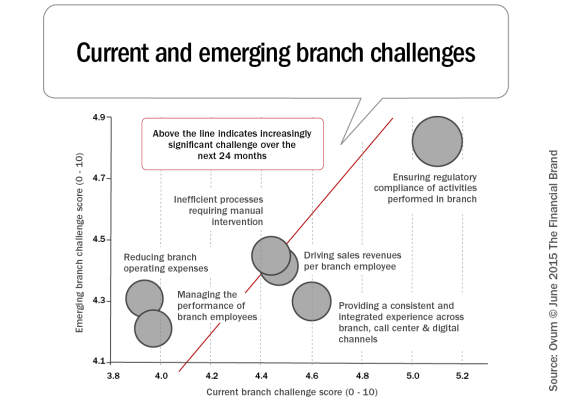Banks around the world are redefining the role and value of the bank branch and transforming how their branches support today’s tech savvy, highly digital customers. Although most banks have begun to implement transformation initiatives, according to a recent study by research firm Ovum titled, “The Role of Workforce Optimization in Bank Branch Transformation,” banks must move “beyond transaction automation and self-service” and address changing customer and market needs if they want the branch to remain a relevant and effective element of their services. The independent global research conducted by Ovum and commissioned by Verint involved 300 key decision-makers responsible for their bank’s branch strategy and is included in this recently published study.
According to Ovum, banks must take a broader perspective when developing their ongoing branch transformation strategy and look beyond cost reduction and automation – although these remain essential requirements. As the report states, “Implicit in this broader approach is optimization of the branch workforce and the need to ensure that staff remain focused on the most critical customer interactions and are as productive as possible in undertaking them.”
As retail banking products become increasingly commoditized and essentially indistinguishable, the customer’s experience with the branch staff may be the best opportunity for the bank to differentiate itself. In fact, when asked what the key branch technology investments will be over the next 18 months, retail banking executives indicated that their top priority was “monitoring interactions between branch employees and customers to improve customer satisfaction.” Ovum asserts that combining automation and self-service in the branch, with a highly productive and enabled staff, will deliver a better branch experience for the customer, helping to increase customer satisfaction.
Although many banks across the globe are still in the relatively early phase of their branch transformation initiatives, focusing primarily on reducing branch and transaction costs, the focus in more mature markets is on making the best use of the branch staff – shifting from traditional transaction-oriented activities to sales and service-focused roles. Supporting this critical transition in employee focus, respondents indicated that the priority challenge for branches in the next 24 months will be managing the performance of branch employees.


Fractional Marketing for Financial Brands
Services that scale with you.

Unlocking Digital Acquisition: A Bank’s Journey to Become Digital-First
This webinar will offer a comprehensive roadmap for digital marketing success, from building foundational capabilities and structures and forging strategic partnerships, to assembling the right team.
Read More about Unlocking Digital Acquisition: A Bank’s Journey to Become Digital-First
The Ovum report confirms that customer demands for true omnichannel service are well recognized by banks. While many have made considerable investment in implementing digital channels in recent years, the majority is unable, as yet, to offer a seamlessly integrated experience that encompasses online and the branch, another significant challenge for banks.

Another conclusion Ovum makes in the report is that a key component for successful branch transformation includes workforce optimization software that is integrated across contact centers, back offices and regional hubs, to help support staffing and scheduling of resources needed to deliver a true omnichannel customer experience. Ensuring the branch remains a relevant and effective element of a bank’s services mix means that branch transformation will be an on-going and evolving process.







